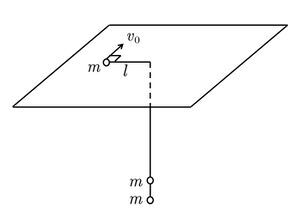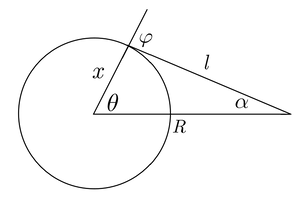欢迎来到奇葩栖息地!欢迎加入Discord服务器:XfrfHCzfbW。请先至特殊:参数设置验证邮箱后再进行编辑。在特殊:参数设置挑选自己想要使用的小工具!不会编辑?请至这里学习Wikitext语法。
物竞小黑板:修订间差异
Microcandela(讨论 | 贡献) 无编辑摘要 |
Microcandela(讨论 | 贡献) 无编辑摘要 |
||
| 第54行: | 第54行: | ||
== 一点数学 == |
== 一点数学 == |
||
===几何法 |
===几何法(一)=== |
||
''设<math>x < R</math> , 求<math> \int_{0}^{\pi} \frac{\sin^3 \theta}{(x^2+R^2-2xR \cos \theta)^{\frac{3}{2}}}\,\textup{d}\theta</math>'' |
''设<math>x < R</math> , 求<math> \int_{0}^{\pi} \frac{\sin^3 \theta}{(x^2+R^2-2xR \cos \theta)^{\frac{3}{2}}}\,\textup{d}\theta</math>'' |
||
2024年5月12日 (日) 05:16的版本
这是一个菜狗创建的页面,目的是为了帮助大家热爱物理竞赛,欢迎大家一起编辑,也请大家帮助指出其中的错误。请各位在讨论中提出认为需要改进的地方。
“高考易错题”
谈到高考易错题,大多数人想到的是学生容易做错的题目。但我们这里讨论一些老师容易出错的题目。
例1

在一个光滑水平面上有一孔,中间穿过一根轻绳,桌面上的一段连接一个质量为[math]\displaystyle{ m }[/math]的球,桌面下的一段连接两个质量为[math]\displaystyle{ m }[/math]的球,桌面上绳长初态为[math]\displaystyle{ l }[/math]。桌面上的球以切向速度[math]\displaystyle{ v_0=\sqrt{gl} }[/math]绕孔做圆周运动。现在释放绳,问桌面上绳最短为多长?
我们设桌面上的绳缩短量为[math]\displaystyle{ x }[/math],则我们需要算出[math]\displaystyle{ x_\rm{max} }[/math]的值。
如果这题被老师一时兴起出到高考试卷上,那么解题过程应该是这样的:
由能量守恒:[math]\displaystyle{ \frac{1}{2}mv_0^2 = \frac{1}{2}mv_1^2 - 2mgx }[/math] ①
由牛顿第二定律:[math]\displaystyle{ \frac{mv_1^2}{l - x} = 2mg }[/math] ②
然而这样做是不对的。这里默认了[math]\displaystyle{ x_\rm{max} }[/math]时沿绳方向的加速度只有向心加速度。事实上,此时沿绳不止有向心加速度,桌面下方的[math]\displaystyle{ 2m }[/math]会再次上升,原因在最后会解释。
那我们怎样解决这个问题呢?我们可以使用角动量。
由[math]\displaystyle{ \vec{F} = m \vec{a} }[/math]:
[math]\displaystyle{ \vec{r} \times \vec{F} \cdot \Delta t = \vec{r} \times m \vec{a} \cdot \Delta t }[/math]
[math]\displaystyle{ \vec{M} \cdot \Delta t = \vec{r} \times m \Delta \vec{v} }[/math]
又[math]\displaystyle{ \Delta (\vec{r} \times m \vec{v}) }[/math]
[math]\displaystyle{ = \Delta \vec{r} \times m \vec{v} + \vec{r} \times \Delta (m \vec{v}) }[/math]
[math]\displaystyle{ = \vec{v} \cdot \Delta t \times m \vec{v} + \vec{r} \times m \Delta \vec{v} }[/math]
[math]\displaystyle{ = 0 + \vec{r} \times m \Delta \vec{v} }[/math]
所以[math]\displaystyle{ \vec{M} \cdot \Delta t = \Delta (\vec{r} \times m \vec{v}) }[/math]
记作[math]\displaystyle{ \vec{H} = \Delta \vec{L} }[/math]
其中,[math]\displaystyle{ \vec{H} }[/math]是角冲量,[math]\displaystyle{ \vec{L} }[/math]是角动量。
在此题中,使用角动量是好的。因为桌面上的小球受到绳的力是有心力,即:若选孔为支点,则运动过程中绳上拉力力臂始终为0,力矩为0,角动量守恒。
由此,得方程:[math]\displaystyle{ m v_0 l = m v_1 (l-x) }[/math] ③
联立①③,得[math]\displaystyle{ x_\rm{max}=\frac{7-\sqrt{17}}{8} }[/math][math]\displaystyle{ l }[/math]
由这个结果不难发现,[math]\displaystyle{ x_\rm{max} }[/math]时,向心加速度为[math]\displaystyle{ \frac{-13+5\sqrt{17}}{2}g \gt 2g }[/math],说明我们之前的想法是正确的。
这个问题就轻松而愉快地解决了!
一点数学
几何法(一)
设[math]\displaystyle{ x \lt R }[/math] , 求[math]\displaystyle{ \int_{0}^{\pi} \frac{\sin^3 \theta}{(x^2+R^2-2xR \cos \theta)^{\frac{3}{2}}}\,\textup{d}\theta }[/math]
答案:[math]\displaystyle{ \frac{4}{3R^3} }[/math]
本题的常规解法是将分子上的一个[math]\displaystyle{ \sin\theta }[/math]放进[math]\displaystyle{ \textup{d}\theta }[/math]里,以[math]\displaystyle{ \cos\theta }[/math]为变元进行积分。然而这样的积分还需进行繁杂的换元操作,计算起来煞费功夫。
然而我们进行一些观察就能得到一些“巧妙”的细节:从题面入手,分母是齐次式,并且具有余弦定理的形式;从答案入手,答案中竟然不含[math]\displaystyle{ x }[/math],又可以发现[math]\displaystyle{ \frac{4}{3}=\int_{0}^{\pi} \sin^3 \theta\,\textup{d}\theta }[/math]。这一切似乎都在将我们引向一个更好的解法:几何法。

各量的意义已在图中标明。
由余弦定理,不难得出[math]\displaystyle{ l=\sqrt{x^2+R^2-2xR \cos \theta} }[/math]
由正弦定理,不难得出[math]\displaystyle{ \frac{\sin\theta}{l}=\frac{\sin\varphi}{R}=\frac{\sin\alpha}{x} }[/math]
由图中的几何关系,[math]\displaystyle{ \textup{d}\theta=\textup{d}\varphi-\textup{d}\alpha }[/math]
考虑到[math]\displaystyle{ x \lt R }[/math]的条件下,[math]\displaystyle{ \theta :0 \rightarrow \frac{\pi}{2} }[/math]的过程对应[math]\displaystyle{ \varphi :0 \rightarrow \frac{\pi}{2} }[/math]和[math]\displaystyle{ \alpha :0 \rightarrow 0 }[/math]
于是有[math]\displaystyle{ \int_{0}^{\pi} \frac{\sin^3 \theta}{(x^2+R^2-2xR \cos \theta)^{\frac{3}{2}}}\,\textup{d}\theta = \int_{0}^{\pi} \frac{\sin^3 \theta}{(x^2+R^2-2xR \cos \theta)^{\frac{3}{2}}}\,\textup{d}\varphi - \int_{0}^{0} \frac{\sin^3 \theta}{(x^2+R^2-2xR \cos \theta)^{\frac{3}{2}}}\,\textup{d}\alpha }[/math]
[math]\displaystyle{ = \int_{0}^{\pi} \frac{\sin^3 \varphi}{R^3}\,\textup{d}\varphi - \int_{0}^{0} \frac{\sin^3 \alpha}{x^3}\,\textup{d}\alpha }[/math]
[math]\displaystyle{ =\frac{4}{3R^3} }[/math]
我们可以自然地由几何得到,这个积分的结果和[math]\displaystyle{ x }[/math]与[math]\displaystyle{ R }[/math]的大小关系有关。
Microcandela(留言)于2024年4月独立得出以上结果。
Microcandela(留言) 2024年5月11日 (六) 15:42 (UTC) 时隔3年,再度编写此条目。
| 数学 |
| ||||
|---|---|---|---|---|---|
| 物理 |
| ||||
| 化学 |
| ||||
| 信息学 |
| ||||
| 生物学 |
| ||||
| 其他 | |||||
